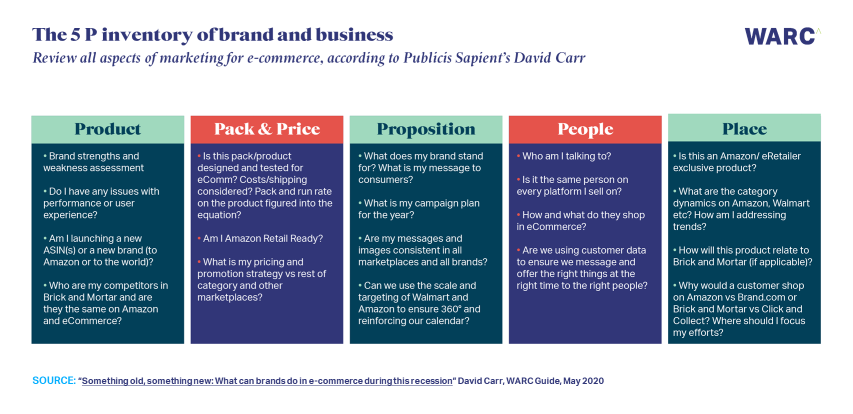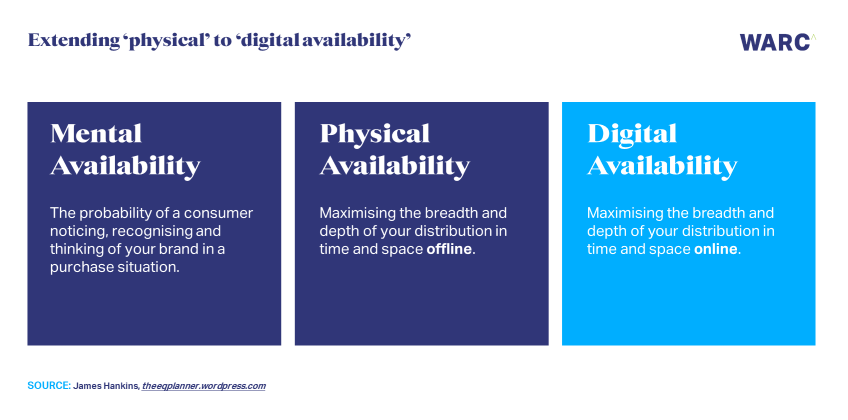Last week, WARC published the WARC Guide to E-commerce and the Future of Effectiveness, with examples, expertise and guidance to help marketers navigate challenges and seize new opportunities, as they map out a path to recovery. Lena Roland, WARC’s Managing Editor, Knowledge Content, looks at four key trends from the report.
1. Marketing goes back to basics
In the e-commerce age, brands need to review the fundamentals of marketing; from product to pricing, everything should be reviewed to see how they can flex for the online world.

For example, with pricing and profitability key considerations, FMCG brands such as Mondelez and Hershey are reviewing pack sizes and multi-buy options.
Delivery is now a new 'moment of truth' for online brands, with packaging a key touchpoint. That moment when the customer receives a package is an opportunity for a brand to showcase its creativity and enhance the brand experience. And unboxing is a moment that marketers can capitalise on.
As well as mental and physical availability, brands may need to plan for digital availability too. In other words, marketers need to have a strategy for how and where they show up online.

In addition to the basics, like visibility in search, brands should also prioritise influential factors like strong online reviews. A recent report by Google and The Behavioural Architects shows that social proof can influence consumer decision-making and therefore help win the ‘digital shelf’. Getting on consumers’ digital shopping lists where goods are ordered on auto-pilot, or repeat, will be a key objective for online brands.
The bottom line: Strong reviews, great comments and positive delivery experiences are crucial for online brands.
Our advice: Try to ensure customers have a positive brand experience across all touchpoints. And make first-party data an objective. Direct-to-consumer models can help build direct relationships with shoppers.
2. The shift to shoppable media
The shift to e-commerce is transforming performance marketing. “In the previous decade of search engines commanding the bulk of the budget for bottom of the funnel conversion, Google and Baidu may have reigned. In today’s world, e-commerce platforms offer much more return on conversion investments”, says Alex Zhang, APAC Head of Strategy, VCCP.
Amazon has seen record growth in the face of the COVID-19 outbreak, according to the latest company reports. Total net sales reached $88.9bn in Q2 2020, the highest level ever recorded. This is also a year-on-year increase of 40.2% ($25.5bn), the second-quickest rate of growth ever.

Revenue from the online stores segment has skyrocketed, reaching $45.9bn in Q2 2020. This is a year-on-year increase of 47.8%, the quickest rate of growth ever and double the rate of the previous high (+24.3% in Q1 2020). Revenue from third-party seller services like fulfilment and shipping grew 52.1% in Q2 2020, the highest rate ever and taking the total to $18.2bn.
Advertising revenue also grew rapidly in the second quarter, rising 40.6% to $4.2bn.
This contrasts with the performance of Google Search where revenue dropped 9.8% year-on-year, according to the latest company reports.
E-commerce platforms like Alibaba in China offer a range of advertising options to capture as much of the purchase journey as possible, from awareness and engagement right through to purchase. This promises a seamless customer journey, with no need to leave the site to make the purchase. Unsurprisingly, other platforms such as Amazon are following suit.
Shoppable ads are now a key trend in digital advertising, very recently social platforms such as Facebook, Instagram and YouTube have extended their reach into e-commerce by developing shoppable formats and storefronts within their platforms.
Omnichannel retailers like Walmart and Target are getting in on the action too. They are becoming advertising and media destinations in their own right by ramping up their e-commerce capabilities.
The bottom line: E-commerce battles will intensify in 2020 and beyond.
Our advice: Firms should give careful consideration for how a brand “shows up” on marketplaces and e-commerce sites. Marketers need to understand the trade-offs on these platforms.
3. The dangers of short-termism
The rise of shoppable formats and e-commerce media is likely to accelerate the shift toward short-termism identified by researchers such as Les Binet and Peter Field. And that will only be compounded by recession. According to Alphabet’s latest company reports, YouTube has been a driver of growth for the business. Interestingly the company reported “substantial growth in direct response” advertising but a “continued decline in brand advertising”.
Brands such as Adidas and Expedia have been upfront about the lure of short-termism, and have taken steps to course correct. Our report shows that brand-building remains crucial in the e-commerce age. There is evidence that a strong brand is key to driving traffic and maintaining price premiums online.
The bottom line: Strong brands have multiple benefits including justifying a price premium in online marketplaces. Strong brands also signify trust, which is especially important in difficult times, and especially important online.
Our advice: Maintain a balanced approach to long vs. short-term marketing investment – this still matters. It’s not a question of investment in either/or – it’s a smart blend of both.
4. The rise of livestreaming
Livestreaming is booming in China. Discount-driven and convenience-led, livestreaming is particularly suited to products that have a short decision cycle, such as food, fashion and beauty.
The latest phase of livestreaming puts Chinese business leaders centre stage with executives from brands such as McDonald’s called on to engage consumers and even launch new products.
The bottom line: Brands in other markets should assess the pros and cons of livestreaming.
Our advice: Livestreaming is significant because it blends three major digital marketing trends: video, influencers and e-commerce; marketers in the West should therefore expect to see some kind of parallel development.
The WARC Guide to E-commerce and the Future of Effectiveness is available to subscribers here (non-subscribers can download a sample report here.)
To complement the guide, there’ s more coming from WARC during September:
• A series of free-to-join related webinars from September 3rd: WARC Talks 360 – Your guide to e-commerce and the future of effectiveness.
• A C-suite masterclass video series: early September 2020
• WARC Global Advertising Trends - data on e-commerce: mid-September 2020
Before then you can also catch up with WARC’s Effectiveness in the age of e-commerce keynote session, first screened at Cannes Lions Live.

